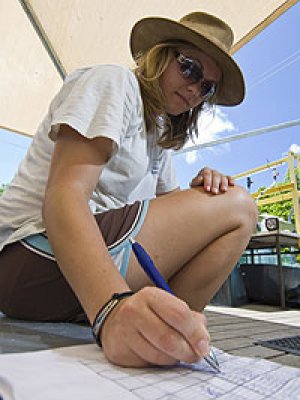
When it comes to sex, sea sponges are certainly not monogamous.
But, thanks to a project based at the Heron Island Research Station, UQ researchers will uncover whether the marine animals are partaking in an underwater orgy, or if reproduction is a little harder to come by.
The study forms Karin Maritz’s Honours thesis in ecological genetics and has involved the work of research assistant Andrew Calcino.
“They definitely mate multiple times, there’s no doubt about that,” Ms Maritz said.
“Now we’re just trying to figure out how choosy they are, if they really will just mate with any sperm or pick some over another.”
The research duo randomly selected a few individual sponges as the maternal focal points of their study and are now mapping the genetics of every other sponge within a four-metre radius.
Because every sponge can act as both a male and a female, they all have the potential to contribute sperm to their neighbours.
The genetic mapping will identify whether or not some neighbours are more sexually active than others.
Ms Maritz said sea sponges were particularly good animals to work with because, once dissected, they could conceal no secrets about their sexual history.
“These sponges actually care for their young – their embryos and larvae grow up inside the sponge so they’re completely protected and it’s only when they’re ready to swim off into the big wide world that they’re released from the sponge,” she said.
“When we dissect a sponge we can take out every single progeny that that sponge has produced and we can genotype them and figure out how many different fathers have contributed.
“We can then go out and map where those fathers are living on the reef relative to where the mother is living so we can figure out how far the sperm must be travelling once it’s expelled from a particular adult.
“If we can’t identify the father, we know that the sperm has travelled further than the four-metre radius we have mapped.
“We’re trying to figure out whether there are enough sponge sperm floating around out there to keep a mother constantly busy producing more young.
“If this is the case, it gives mothers the opportunity to be picky – will they just accept any sperm that comes from any male around them or choose one over another, even it means the sperm has to travel further?”
Ms Maritz’s thesis is supervised by Dr Sandie Degnan from UQ’s School of Biological Sciences.
Media: Sandie Degnan (3346 9005, s.degnan@uq.edu.au) or Penny Robinson at UQ Communications (07 3365 9723 penny.robinson@uq.edu.au)




